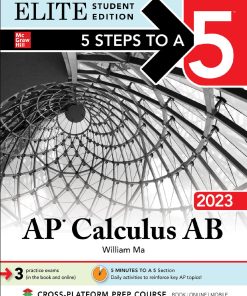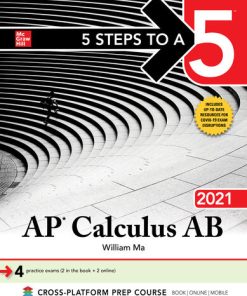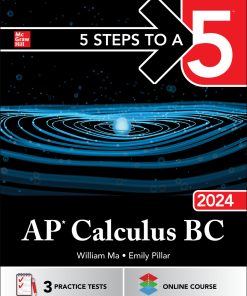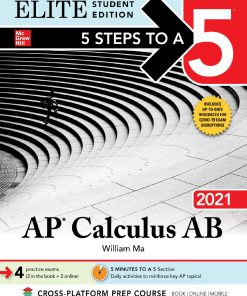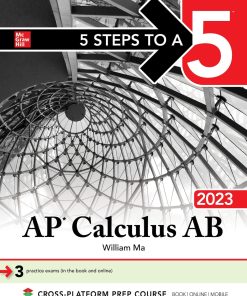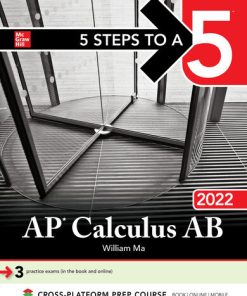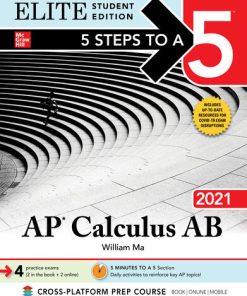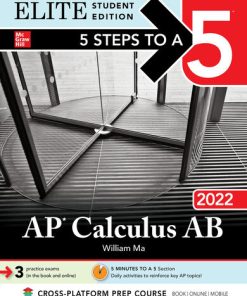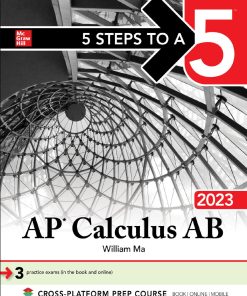(EBook PDF) 5 Steps to a 5 AP Calculus AB 2024 1st edition by William Ma, Emily Pillar 1265351627 9781265351625 full chapters
$50.00 Original price was: $50.00.$25.00Current price is: $25.00.
5 Steps to a 5: AP Calculus AB 2024 1st edition by William Ma, Emily Pillar – Ebook PDF Instant Download/DeliveryISBN: 1265351627, 9781265351625
Full download 5 Steps to a 5: AP Calculus AB 2024 1st edition after payment
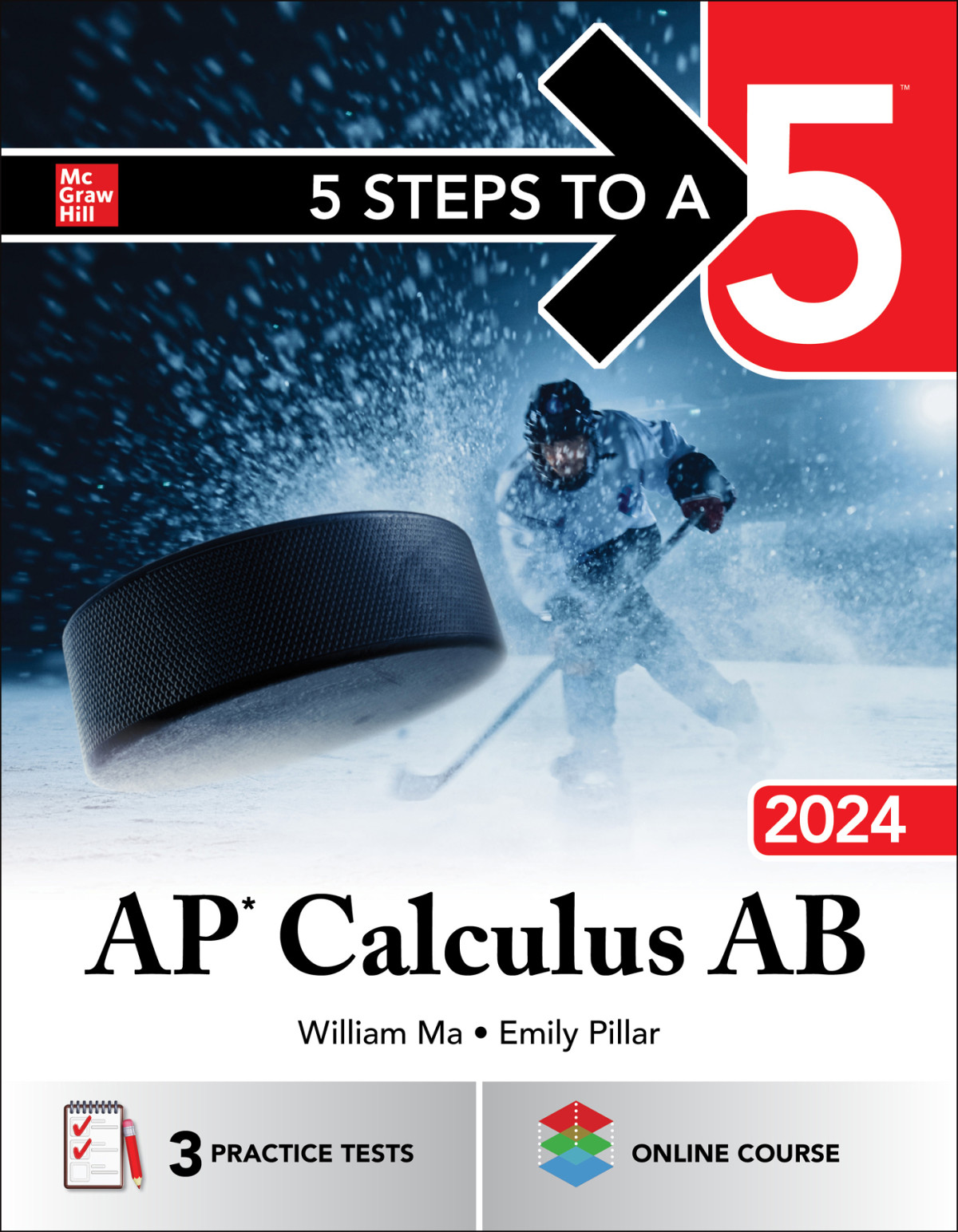
Product details:
ISBN-10 : 1265351627
ISBN-13 : 9781265351625
Author: William Ma, Emily Pillar
AP Teachers’ #1 Choice! Ready to succeed in your AP course and ace your exam? Our 5 Steps to a 5 guides explain the tough stuff, offer tons of practice and explanations, and help you make the most efficient use of your study time. 5 Steps to a 5: AP Calculus AB is more than a review guide, it’s a system that has helped thousands of students walk into test day feeling prepared and confident. Everything You Need for a 5: 3 full-length practice tests that align with the latest College Board requirements Hundreds of practice exercises with answer explanations Comprehensive overview of all test topics Proven strategies from seasoned AP educators Study on the Go: All instructional content in digital format (available online and on mobile devices) Interactive practice tests with answer explanations A self-guided, personalized study plan with daily goals, powerful analytics, flashcards, games, and more A Great In-class Supplement: 5 Steps is an ideal companion to your main AP text Includes an AP Calculus AB Teacher’s Manual that offers excellent guidance to educators for better use of the 5 Steps resources
5 Steps to a 5: AP Calculus AB 2024 1st Table of contents:
STEP 1 Set Up Your Study Plan
1 What You Need to Know About the AP Calculus AB Exam
1.1 What Is Covered on the AP Calculus AB Exam?
1.2 What Is the Format of the AP Calculus AB Exam?
1.3 What Are the Advanced Placement Exam Grades?
How Is the AP Calculus AB Exam Grade Calculated?
1.4 Which Graphing Calculators Are Allowed for the Exam?
Calculators and Other Devices Not Allowed for the AP Calculus AB Exam
Other Restrictions on Calculators
2 How to Plan Your Time
2.1 Three Approaches to Preparing for the AP Calculus AB Exam
Overview of the Three Plans
2.2 Calendar for Each Plan
Summary of the Three Study Plans
STEP 2 Determine Your Test Readiness
3 Take a Diagnostic Exam
3.1 Getting Started!
3.2 Diagnostic Test
3.3 Answers to Diagnostic Test
3.4 Solutions to Diagnostic Test
3.5 Calculate Your Score
Short-Answer Questions
AP Calculus AB Diagnostic Test
STEP 3 Develop Strategies for Success
4 How to Approach Each Question Type
4.1 The Multiple-Choice Questions
4.2 The Free-Response Questions
4.3 Using a Graphing Calculator
4.4 Taking the Exam
What Do I Need to Bring to the Exam?
Tips for Taking the Exam
STEP 4 Review the Knowledge You Need to Score High
5 Review of Precalculus
5.1 Lines
Slope of a Line
Equations of a Line
Parallel and Perpendicular Lines
5.2 Absolute Values and Inequalities
Absolute Values
Inequalities and the Real Number Line
Solving Absolute Value Inequalities
Solving Polynomial Inequalities
Solving Rational Inequalities
5.3 Functions
Definition of a Function
Operations on Functions
Inverse Functions
Trigonometric and Inverse Trigonometric Functions
Exponential and Logarithmic Functions
5.4 Graphs of Functions
Increasing and Decreasing Functions
Intercepts and Zeros
Odd and Even Functions
Shifting, Reflecting, and Stretching Graphs
5.5 Rapid Review
5.6 Practice Problems
5.7 Cumulative Review Problems
5.8 Solutions to Practice Problems
5.9 Solutions to Cumulative Review Problems
Big Idea 1: Limits
6 Limits and Continuity
6.1 The Limit of a Function
Definition and Properties of Limits
Evaluating Limits
One-Sided Limits
Squeeze Theorem
6.2 Limits Involving Infinities
Infinite Limits (as x → a)
Limits at Infinity (as x → ±∞)
Horizontal and Vertical Asymptotes
6.3 Continuity of a Function
Continuity of a Function at a Number
Continuity of a Function over an Interval
Theorems on Continuity
6.4 Rapid Review
6.5 Practice Problems
6.6 Cumulative Review Problems
6.7 Solutions to Practice Problems
6.8 Solutions to Cumulative Review Problems
Big Idea 2: Derivatives
7 Differentiation
7.1 Derivatives of Algebraic Functions
Definition of the Derivative of a Function
Power Rule
The Sum, Difference, Product, and Quotient Rules
The Chain Rule
7.2 Derivatives of Trigonometric, Inverse Trigonometric, Exponential, and Logarithmic Functions
Derivatives of Trigonometric Functions
Derivatives of Inverse Trigonometric Functions
Derivatives of Exponential and Logarithmic Functions
7.3 Implicit Differentiation
Procedure for Implicit Differentiation
7.4 Approximating a Derivative
7.5 Derivatives of Inverse Functions
7.6 Higher Order Derivatives
7.7 L’Hôpital’s Rule for Indeterminate Forms
7.8 Rapid Review
7.9 Practice Problems
7.10 Cumulative Review Problems
7.11 Solutions to Practice Problems
7.12 Solutions to Cumulative Review Problems
8 Graphs of Functions and Derivatives
8.1 Rolle’s Theorem, Mean Value Theorem, and Extreme Value Theorem
Rolle’s Theorem
Mean Value Theorem
Extreme Value Theorem
8.2 Determining the Behavior of Functions
Test for Increasing and Decreasing Functions
First Derivative Test and Second Derivative Test for Relative Extrema
Test for Concavity and Points of Inflection
8.3 Sketching the Graphs of Functions
Graphing without Calculators
Graphing with Calculators
8.4 Graphs of Derivatives
8.5 Rapid Review
8.6 Practice Problems
8.7 Cumulative Review Problems
8.8 Solutions to Practice Problems
8.9 Solutions to Cumulative Review Problems
9 Applications of Derivatives
9.1 Related Rate
General Procedure for Solving Related Rate Problems
Common Related Rate Problems
Inverted Cone (Water Tank) Problem
Shadow Problem
Angle of Elevation Problem
9.2 Applied Maximum and Minimum Problems
General Procedure for Solving Applied Maximum and Minimum Problems
Distance Problem
Area and Volume Problems
Business Problems
9.3 Rapid Review
9.4 Practice Problems
9.5 Cumulative Review Problems
9.6 Solutions to Practice Problems
9.7 Solutions to Cumulative Review Problems
10 More Applications of Derivatives
10.1 Tangent and Normal Lines
Tangent Lines
Normal Lines
10.2 Linear Approximations
Tangent Line Approximation (or Linear Approximation)
Estimating the nth Root of a Number
Estimating the Value of a Trigonometric Function of an Angle
10.3 Motion Along a Line
Instantaneous Velocity and Acceleration
Vertical Motion
Horizontal Motion
10.4 Rapid Review
10.5 Practice Problems
10.6 Cumulative Review Problems
10.7 Solutions to Practice Problems
10.8 Solutions to Cumulative Review Problems
Big Idea 3: Integrals and the Fundamental Theorems of Calculus
11 Integration
11.1 Evaluating Basic Integrals
Antiderivatives and Integration Formulas
Evaluating Integrals
11.2 Integration by U-Substitution
The U-Substitution Method
U-Substitution and Algebraic Functions
U-Substitution and Trigonometric Functions
U-Substitution and Inverse Trigonometric Functions
U-Substitution and Logarithmic and Exponential Functions
11.3 Rapid Review
11.4 Practice Problems
11.5 Cumulative Review Problems
11.6 Solutions to Practice Problems
11.7 Solutions to Cumulative Review Problems
12 Definite Integrals
12.1 Riemann Sums and Definite Integrals
Sigma Notation or Summation Notation
Definition of a Riemann Sum
Definition of a Definite Integral
Properties of Definite Integrals
12.2 Fundamental Theorems of Calculus
First Fundamental Theorem of Calculus
Second Fundamental Theorem of Calculus
12.3 Evaluating Definite Integrals
Definite Integrals Involving Algebraic Functions
Definite Integrals Involving Absolute Value
Definite Integrals Involving Trigonometric, Logarithmic, and Exponential Functions
Definite Integrals Involving Odd and Even Functions
12.4 Rapid Review
12.5 Practice Problems
12.6 Cumulative Review Problems
12.7 Solutions to Practice Problems
12.8 Solutions to Cumulative Review Problems
13 Areas and Volumes
13.1 The Function F(x) = ∫xa f(t)dt
13.2 Approximating the Area Under a Curve
Rectangular Approximations
Trapezoidal Approximations
13.3 Area and Definite Integrals
Area Under a Curve
Area Between Two Curves
13.4 Volumes and Definite Integrals
Solids with Known Cross Sections
The Disc Method
The Washer Method
13.5 Rapid Review
13.6 Practice Problems
13.7 Cumulative Review Problems
13.8 Solutions to Practice Problems
13.9 Solutions to Cumulative Review Problems
14 More Applications of Definite Integrals
14.1 Average Value of a Function
Mean Value Theorem for Integrals
Average Value of a Function on [a, b]14.2 Distance Traveled Problems
14.3 Definite Integral as Accumulated Change
Business Problems
Temperature Problem
Leakage Problem
Growth Problem
14.4 Differential Equations
Exponential Growth/Decay Problems
Separable Differential Equations
14.5 Slope Fields
14.6 Rapid Review
14.7 Practice Problems
14.8 Cumulative Review Problems
14.9 Solutions to Practice Problems
14.10 Solutions to Cumulative Review Problems
People also search for 5 Steps to a 5: AP Calculus AB 2024 1st:
5 steps to a 5 ap calculus ab pdf
5 steps to a 5 ap calculus bc
5 steps to a 5 ap calculus bc pdf
5 steps to a 5 ap calculus ab 2025
5 steps to a 5 ap calculus pdf
Tags:
5 Steps,AP Calculus,William Ma,Emily Pillar
You may also like…
Reference - School Guides & Test Preparation
5 Steps to a 5: AP Calculus AB 2023 Elite Student Edition William Ma
Mathematics - Differential Equations
Mathematics - Differential Equations
Education Studies & Teaching - Studying & Test Preparation
Education Studies & Teaching
Education Studies & Teaching
Computers & Technology
5 Steps to a 5: AP Calculus AB 2022 Elite Student Edition 1st Edition




